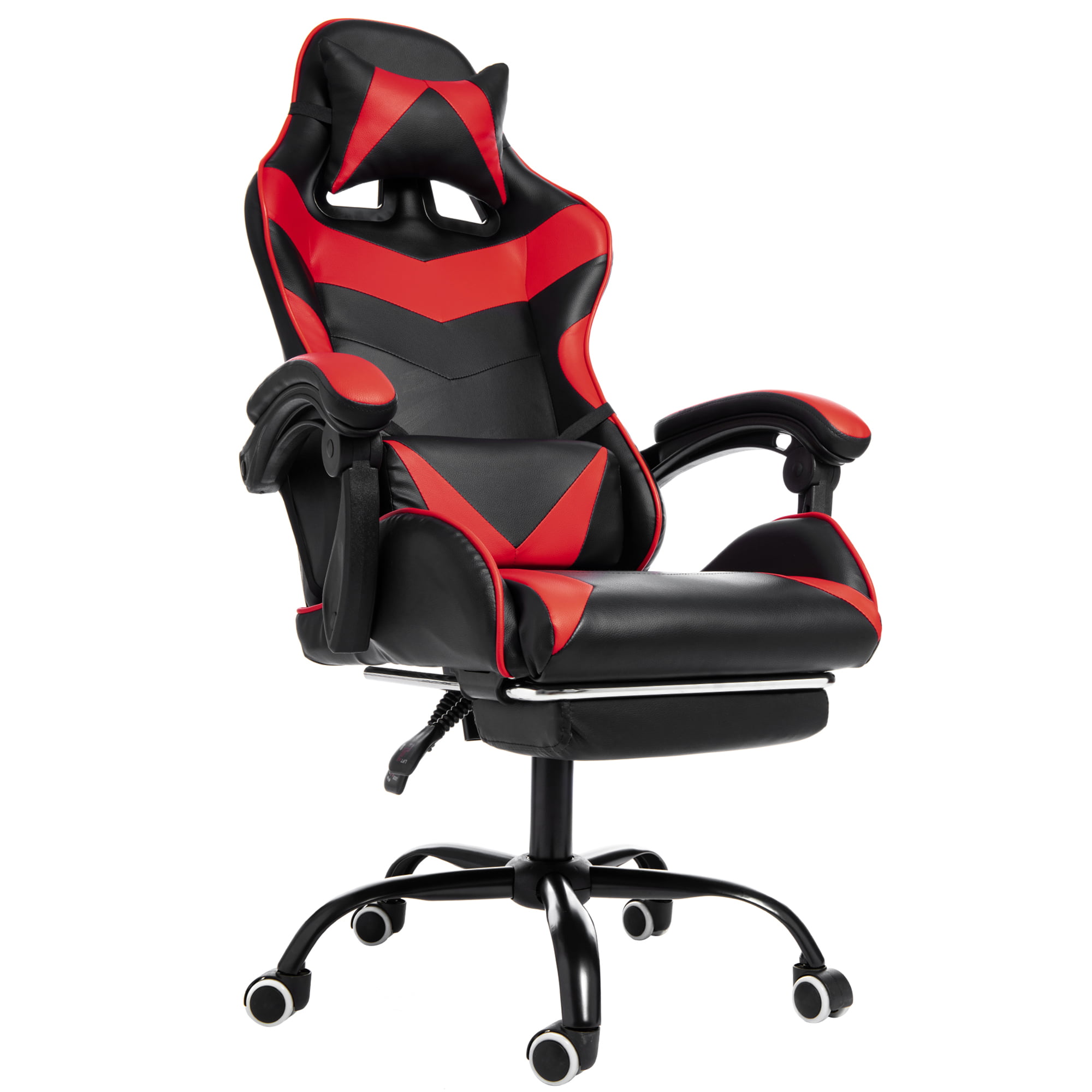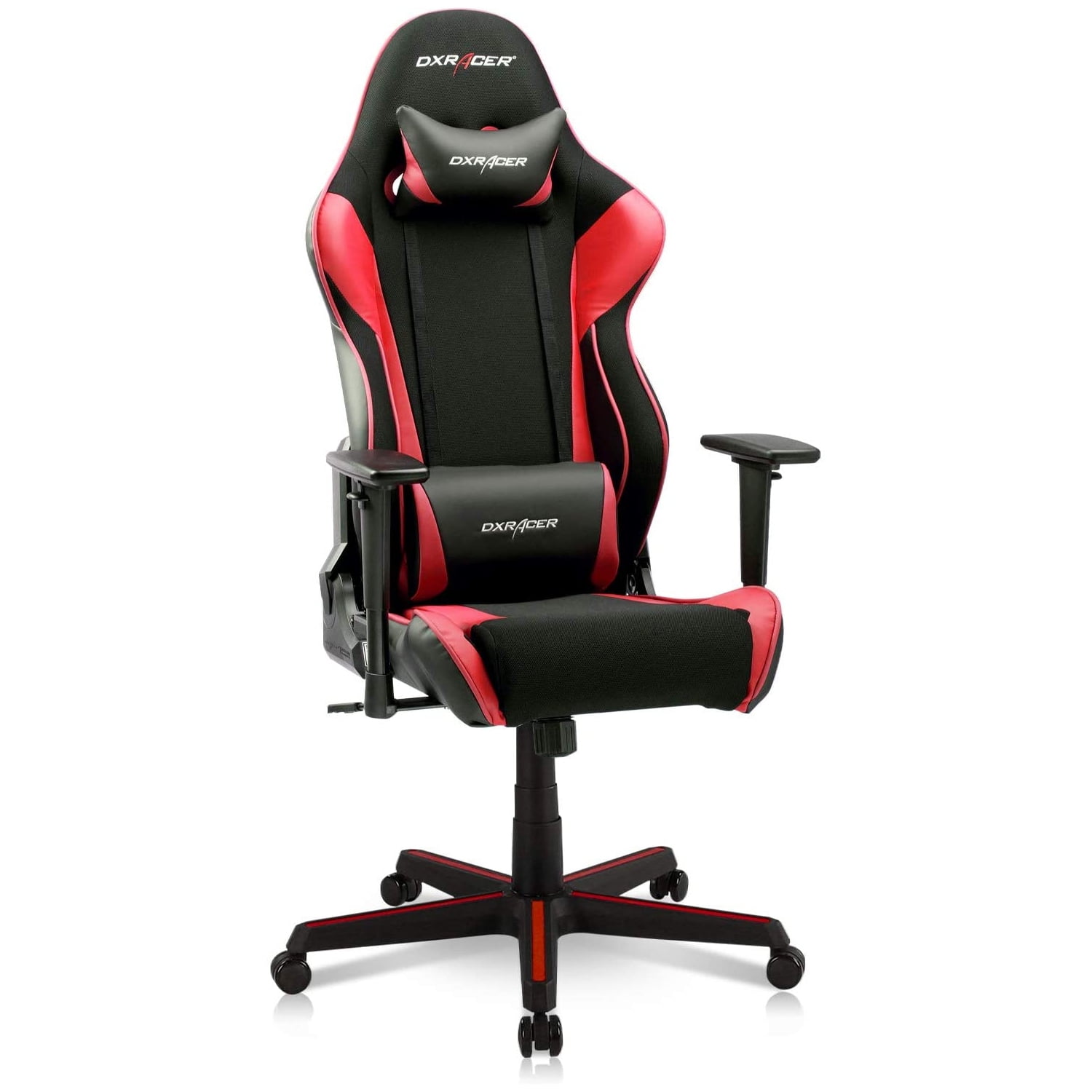Design & Aesthetics of Red and Black Gaming Chairs

Red and black gaming chairs have become a staple in the gaming community, offering a blend of performance and style. The combination of these two colors creates a visually striking aesthetic, often associated with power, speed, and a touch of aggression. This section delves into the design elements, color variations, and a flagship example to illustrate the diverse appeal of this popular chair type.
Design Elements in Red and Black Gaming Chairs
The design of red and black gaming chairs is heavily influenced by ergonomic considerations and aesthetic choices. Manufacturers strive to create chairs that are both comfortable for extended gaming sessions and visually appealing.
- Racing Style: Many red and black gaming chairs adopt a racing-style design, featuring a bucket seat shape for enhanced support and a sculpted backrest to hug the user’s body. This design element is visually striking and evokes a sense of speed and performance.
- Ergonomic Features: Key ergonomic features include adjustable lumbar support, headrests, armrests, and tilt mechanisms. These features allow users to customize the chair’s position for optimal comfort and posture, reducing strain during long gaming sessions.
- Material Choices: Common materials include PU leather (polyurethane leather), genuine leather, and fabric. PU leather is a popular choice due to its durability, ease of cleaning, and affordability. Genuine leather offers a more luxurious feel and enhanced breathability, while fabric options provide breathability and a softer touch. Metal frames are typically used for structural integrity and durability.
Aesthetic Variations of Red and Black Gaming Chairs
The interplay between red and black creates a range of aesthetic effects, each with its own distinct appeal. The shade of red, the finish of the black, and the balance between the two colors all contribute to the overall visual impact.
| Red Shade | Black Finish | Visual Impact | Target Audience |
|---|---|---|---|
| Deep Red Accents | Matte Black | Subdued, sophisticated, elegant | Gamers who prefer a more understated yet stylish look. |
| Crimson Highlights | Glossy Black | Bold, vibrant, high-impact | Gamers who want a chair that makes a statement. |
| Burgundy Accents | Textured Black | Rich, luxurious, premium | Gamers who appreciate high-quality materials and a sophisticated design. |
| Bright Red Piping | Piano Black | Sporty, energetic, dynamic | Gamers who want a chair that reflects their energetic personality. |
Flagship Red and Black Gaming Chair: The “Apex Predator”
The Apex Predator gaming chair represents the pinnacle of red and black design. Its frame is constructed from high-grade steel, ensuring exceptional durability and stability. The seat and backrest are upholstered in supple, breathable genuine leather, accented with vibrant crimson stitching that creates a visually striking contrast against the deep, matte black base. The chair boasts adjustable lumbar support, a height-adjustable headrest, and 4D armrests, all meticulously crafted for optimal ergonomic support. The base is fitted with high-quality caster wheels for smooth movement across any surface. The Apex Predator’s visual impact is powerful and commanding, reflecting the power and precision of a predator. Its target audience is discerning gamers who demand the best in both comfort and aesthetics, valuing premium materials and superior ergonomics. The chair projects an image of luxury and high performance, appealing to a sophisticated gamer who appreciates quality and style.
Ergonomics and Functionality of Red and Black Gaming Chairs

Ergonomic design in gaming chairs is crucial for maximizing comfort and minimizing health risks associated with prolonged sitting. The vibrant aesthetic of red and black chairs shouldn’t overshadow the importance of features that support healthy posture and prevent discomfort during extended gaming sessions. A well-designed chair actively contributes to a positive gaming experience by reducing fatigue and potential long-term health issues.
Red and black gaming chair – Proper ergonomic design considers several key factors to ensure comfort and support during prolonged use. These factors are critical for maintaining healthy posture and preventing discomfort or injury.
Ergonomic Considerations for Prolonged Use
Several key ergonomic factors contribute to the overall comfort and health benefits of a well-designed gaming chair, especially during extended use. These elements work in concert to provide optimal support and minimize strain.
- Lumbar Support: A properly contoured lumbar support adjusts to the natural curve of the spine, preventing slouching and reducing lower back strain. This is especially vital for extended periods of sitting.
- Adjustable Height: The ability to adjust the chair’s height ensures optimal positioning relative to the desk and monitor, promoting proper posture and reducing neck and shoulder strain.
- Seat Depth and Width: Sufficient seat depth prevents pressure points and allows for proper thigh support. Adequate width ensures comfortable seating and prevents restricted movement.
- Armrest Adjustability: Adjustable armrests allow for customization to match individual arm lengths and desk heights, reducing strain on the shoulders, elbows, and wrists.
- Headrest: A supportive headrest promotes proper neck alignment, especially beneficial during long gaming sessions. It helps to prevent neck pain and stiffness.
- Breathability: Materials that allow for good air circulation help to prevent overheating and discomfort, especially during intense gaming sessions. This is crucial for maintaining comfort.
- Tilt Mechanism: A smoothly operating tilt mechanism allows for dynamic seating positions, relieving pressure and promoting better blood flow. This feature contributes to improved comfort and reduces stiffness.
Adjustable Features and User Experience, Red and black gaming chair
The adjustability of a gaming chair’s features directly impacts the user’s comfort and overall gaming experience. The ability to customize the chair to one’s specific needs and preferences is paramount for extended use.
| Feature | Impact on User Experience | Adjustment Range | Benefits |
|---|---|---|---|
| Lumbar Support | Reduces lower back pain and promotes proper spinal alignment. | Height and depth adjustable | Improved posture, reduced fatigue |
| Armrests | Reduces shoulder and elbow strain; allows for comfortable resting of arms. | Height, width, and angle adjustable | Enhanced comfort, reduced strain |
| Seat Height | Ensures proper leg and foot positioning; prevents strain on legs and back. | Variable height adjustment | Improved posture, reduced leg fatigue |
| Tilt Mechanism | Allows for dynamic seating positions, promoting blood flow and reducing stiffness. | Variable recline angle | Increased comfort, reduced fatigue |
Ideal Posture and Seating Position Illustrations
The following descriptions illustrate ideal posture and seating positions within a red and black gaming chair, highlighting how its features contribute to proper spinal alignment and comfort.
Illustration 1: Correct Sitting Posture. Depicts a person sitting upright in the chair with their feet flat on the floor, their back supported by the chair’s backrest, and their lumbar support properly adjusted to the curve of their lower back. The head is held up straight, the shoulders are relaxed, and the arms are resting comfortably on the armrests. The chair’s tilt is slightly reclined for optimal comfort. This posture minimizes strain on the spine, neck, and shoulders.
Illustration 2: Adjusting Lumbar Support. Shows a close-up of the lumbar support adjusting to the curvature of the user’s spine. The illustration highlights how the adjustable lumbar support conforms to the natural curve, providing targeted support and preventing slouching. The correct adjustment minimizes lower back pain and promotes proper spinal alignment.
Illustration 3: Armrest Positioning. Illustrates the proper adjustment of armrests to support the forearms while typing or using a mouse. The arms are bent at a 90-degree angle at the elbows, and the wrists are straight. This position reduces strain on the shoulders, elbows, and wrists, preventing carpal tunnel syndrome and other repetitive strain injuries.
Illustration 4: Using the Tilt Mechanism. Shows a person slightly reclining in the chair, using the tilt mechanism to relieve pressure on the spine. The illustration highlights the benefits of dynamic seating positions, allowing for changes in posture to promote blood circulation and reduce stiffness.
